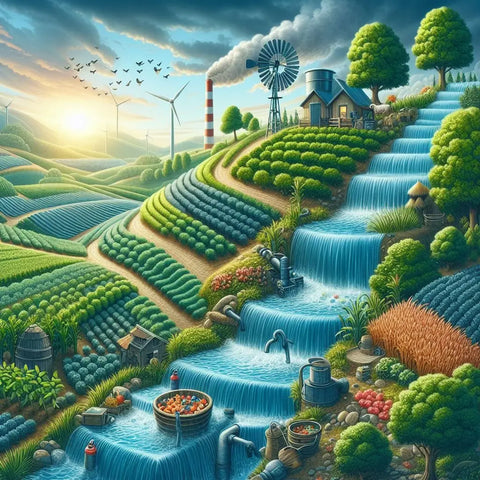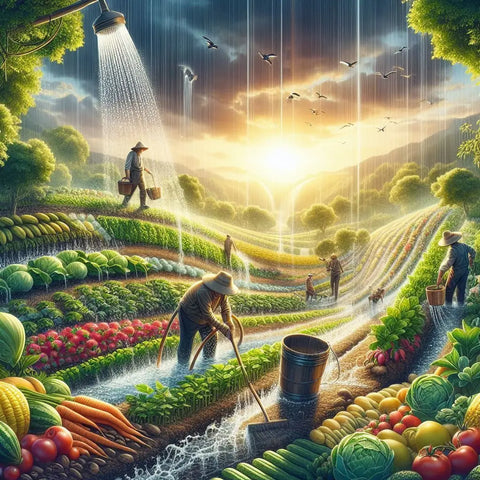Permaculture Farming: A Solution for Water Conservation
Best Practices for Water Conservation in Permaculture Farming
In the age of water scarcity and climate change accentuation, where deliberate water conservation is becoming significant for farmers worldwide, Permaculture farming, an integrated system of sustainable agriculture, is a toolbox of various techniques that minimize water usage while determining crop yields at the same time. Through the implementation of these approaches, permaculture farms save their surroundings from degradation while also providing the farms with a resilient and productive life.

Embracing Water-Wise Landscape Design
One of the main principles of permaculture farming systems is to optimize the benefits of nature, and this involves a thoughtful decrease in water consumption as well. A thoughtful and properly organized water-harvesting system for a permaculture landscape should comprise the components that provide, store, and optimally distribute water. Swale, berm, and contour, which are placed strategically at the top of the land surface, subsequently lessen water runoff and avoid soil washing from the land.
A great water-conservation design element would be keyhole gardens, sunken beds, and raised beds. Such keyhole gardens are particularly appreciated for their ability to efficiently use water, as they channel the water and the organic matter into a centrally situated composting basket, from which the plants can draw moisture and nutrition for themselves from the elevated beds.
Implementing mulching and ground cover will help catch raindrops and prevent soil erosion.
The intensive process of mulching is one of the main activities of perm culturists, not only for the conservation of water but also for better soil fertility and the suppression of weeds. Organic materials, including wood chips, straw, and leaves, that are placed around the plant beds help to minimize the amount of evaporation and maintain the moisture of the soil, thus lowering water use.
Another option is ground cover plants, such as clover or vetch, that act as living mulches in this way, exposing the soil to direct sunlight and solar radiation. The dwarf plants can be introduced to perennial food while at the same time providing nitrogen fixation and the run-off of soil.
Implementing Efficient Irrigation Systems
While permaculture farming cherishes the use of natural systems and processes to ensure the widespread development of water, it will be wise to administer irrigation techniques instead of strewing. Drip irrigation and soaker hoses deliver water directly to the roots of plants, whereas the latter also underscores the need for water conservation given the minimized evaporation and water waste.
Furthermore, doing so will include having systems containing greywater that recycle wastewater from the point of use, such as washing and showering, for irrigation purposes, and consequently, the water demand for freshwater will be reduced significantly. It is important to have appropriate filtration and purification to make sure that the water used after greywater irrigation remains safe.
Practicing rainwater harvesting
Using rainwater to capture and store it is the basic farming technique in permaculture because it combines both the conservation of water resources and less dependence on external water sources. Water from rain can be harvested from roofs, greenhouses, and other similar areas using the system of gutters, pipes, and tanks that store them.
The produced drinking water can be injected into irrigation systems, used for domestic purposes, or used as a livestock water supply addition. The introduction of rainwater harvesting systems in a permaculture farm reduces its demands on groundwater or municipal water supply, positively impacting the sustainability of its operation.
The meals and products are made from locally sourced ingredients that are ethically and environmentally responsible.
One of the principles of permaculture farming is keeping diversity to create economies and visions that are resistant to shocks and can reproduce by themselves. By creating plant diversity with companion plants, insectary plants, and beneficial herbs, the farmer can not only support allowable populations of beneficial insects, birds, and even wildlife but also attract them.
These indigenous predators and pollinators are of vital importance to preventive action against pests that usually demand the application of harmful chemical insecticides. On top of that, enhanced biodiversity improves the soil quality, water retention, and stability of the ecosystems in the long run, which somewhere translates into dirt fertility, water retention, and the enhancement of the ecosystem's resilience.
Two system that are beneficial to nature are agroforestry, which integrates perennials and food crops.
Here is the main pillar of permanent agriculture: the provision of crops all year round, such as fruit trees, nut trees, and bushes used in the permaculture system of farming. These holds are made of wood that has extensive networked root systems, which allows them to draw water reserves as deep as the soil can go, making them more drought-resistant than annual planting.
In addition to that, adopting perennial agriculture is also a way to introduce perennial crops into agroforestry systems. Where trees are grown together with crops and livestock, a series of sustainability and water-conservation ecosystems can be created. Trees filter the direct sun and wind and reduce water evaporation, keeping the local temperature within the range of other crops and thus creating a suitable microclimate.
Taking care of traditional practices and indigenous knowledge.
The farmers of permaculture agriculture regard indigenous knowledge and traditional farming methods, which have normally been refined over many years to become adaptive to certain environmental conditions, such as drought, as very important elements and draw on these for inspiration. Aquaponic permaculture offers ways for farmers can learn and implement historical methods for water sustainability while gaining access to indigenous values and techniques.
Here, one can see manifestations of such practices, for instance, the use of classic water harvesting methods like acequia irrigation networks, the cultivation of drought-resistant crops, and the implementation of sustainable land management practices that ascertain soil water retention.
Final Words
Permaculture farming is a dynamic and constantly evolving practice that takes into account both practical and theoretical knowledge and the continuous application of these lessons in real-world scenarios. In response to the changing climate patterns and the water resources that are being strained, permaculture farmers have to keep an open mind to all local, national, and global experiments with water conservation and conservation technologies.

Participating in various workshops organized by permaculture practitioners, meeting more permaculture practitioners, and learning about the latest research and innovations happening in and around the farming community will enable farmers to implement new ideas that address their unique environmental problems.
Using these Best Practices for Water Conservation in Permaculture Farming, farmers's aim is not only the sustainability of farming but also to contribute to solving world water problems. Through deliberate water management, permaculture farming is a road that takes one to an almost self-sustainable and ecologically safer food system where water is valued in every way possible.





Leave a comment